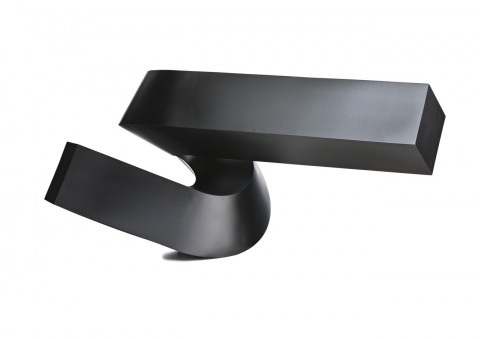VERGE, 1970
CLEMENT MEADMORE
painted steel
61.5 x 124.0 x 87.0 cm
signed, dated, numbered and inscribed with title on base: Verge 1/4 / Meadmore 1971
Max Hutchinson Gallery, New York
Private collection, New York
Heritage Auctions, Dallas, Texas, USA, 23 May 2017, lot 77060
Private collection, Sydney
Clement Meadmore, Max Hutchinson Gallery, New York, 6 – 13 March 1971 (illus. in exhibition catalogue, another example)
Verge, 1970, painted steel, 16.6 x 36.0 x 24.0 ft, Empire State Art Collection, Albany, New York
‘Modern American art came into its own when it stopped trying to be American’.1 It is interesting that Clement Meadmore should say this, for it speaks volumes about his reason for leaving Australia for the USA in 1963. He found the expectation that Australian artists should be working in an Australian idiom was inhibiting his development. He therefore yearned to be near the post war artistic capital of the world and with good reason – America liked Meadmore, suddenly he was hip and accolades and major commissions soon followed.
By the time Meadmore moved to the United States, the international minimalist movement had peaked. Interpreted by many as a logical response to the lofty claims and excesses of abstract expressionism and born out of the cool lines of modernism, the minimalist movement produced giants of twentieth century painting and sculpture: Donald Judd, Ad Reinhardt, Agnes Martin, Richard Serra, and Frank Stella to name few.
However, it is arguable that the elegant curves and the emotional interludes of Meadmore’s work would not have been seen as ‘legit’ by the minimalists and therefore disqualified him from the line-up. But it was the minimalists’ predilection for closed form sculpture which provided a lasting legacy for Meadmore and from 1966 onwards, he worked within a narrow range of forms and materials to create a remarkably even body of work. Eric Gibson has written extensively on the artist, and talks about the artist’s choice of square, tubular metal to create his forms: ‘coupled with the clear-cut edges and smooth surfaces, the blunt ends are the chief means by which his sculptures set themselves off from space. In them line, edge, and plane come together to delineate abruptly and clearly the end of the form and the beginning of space and to keep them clearly separate. They are a way of asserting the sculpture’s status as an object, as something distinct from the space around it’.2
Verge, 1970, is in every way a classic example of Meadmore’s sculpture. The work is book ended with its two square sections, the sculptural equivalent of what is known in jazz as a ‘head’, the chorus with which a piece both begins and ends. Between the heads, an improvisation on the theme takes place, and Meadmore’s theme is the tubular steel sections and the ways in which they are continually reinterpreted. By introducing a simple twist, bend or cut, Meadmore brings a heave of emotion or a flurry of character to an otherwise inert material. In Verge, the artist limits himself to one sweeping gesture and in a perilous moment the work is complete, pivoting at the centre of the movement.
An important player in Meadmore’s career was the Australian Max Hutchinson, who opened an eponymous gallery in New York in 1970. Hutchinson had founded Gallery A in Melbourne in 1959 with Meadmore as the founding director. A trailblazer for the Avant Garde art in Australia, Hutchinson soon outgrew the local scene and, like Meadmore before him, moved to New York. The Max Hutchinson Gallery became an important venue in which Meadmore’s art was brought to the attention of the local audience. The artist went on to have 26 solo exhibitions across America between 1970 and 1980, including three at the Max Hutchinson Gallery, where Verge, was originally purchased.
For all their cool lines and formal concerns Meadmore sculptures remain upbeat, even funky. He was a jazz fan; he played the drums and loved to jam with other hip-cats. The image of Meadmore the jazz drummer, the jammer comes to mind, the base drum keeping the back beat on the stand as the musicians improvise around him. The be-bop, the tempo, the groove, it’s all there, and man – it would have been way too much for the minimalists.
1. The artist quoted in Gibson, E., The Sculpture of Clement Meadmore, Hudson Hill Press, New York, 1994, p. 14
2. Gibson, E., The Sculpture of Clement Meadmore, Hudson Hill Press, New York, 1994, p. 42
HENRY MULHOLLAND
